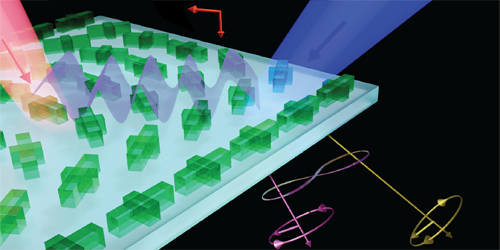Quantum Metasurfaces Entangle Photons on Demand
Precisely designed 2D surfaces called metasurfaces comprise nanoscale arrays of antenna-like structures that scatter light in ways not seen in nature. Metasurfaces have recently been adapted to the quantum realm, with atomic-scale designs that can manipulate individual photons. Now, adding a new dimension to these quantum metasurfaces, Wilton Kort-Kamp and colleagues at Los Alamos National Laboratory, New Mexico, propose a compact photonic platform that continuously alters its light-scattering properties in both space and time. The “space-time quantum metasurface” allows real-time control over coherent light-matter interactions and could enable high-dimensional information encoding and high-capacity communications systems.
Quantum metasurfaces are built from “meta-atom” building blocks—nanoscopic features whose optical properties come from their composition and geometrical design. These meta-atoms typically are arranged in a single layer to create a platform that offers spatial control over quantum light. Rotating some of the meta-atoms relative to one another, for example, can create correlations between a photon’s spin and its path through the metasurface. Kort-Kamp and his colleagues added a temporal component to a metasurface by modulating the optical properties of the meta-atoms via interference between two pump laser beams. When a single probe photon transits through the metasurface, its color, path, twist, and spin can all become entangled with one another, depending on how much electrical polarization each meta-atom experiences when it is illuminated by the pump lasers.
The researchers say that their space-time quantum metasurfaces open a new avenue for research at the intersection of flat optics, quantum information, and nanophotonics. The concept could lead to novel functionalities, such as reconfigurable entanglement for quantum communication, actively steered single-photon quantum emitters, or space- and time-tunable quantum materials for sensing and imaging applications.
–Rachel Berkowitz
Rachel Berkowitz is a Corresponding Editor for Physics Magazine based in Vancouver, Canada.
References
- W. J. M. Kort-Kamp et al., “Space-time quantum metasurfaces,” Phys. Rev. Lett. 127, 043603 (2021).




